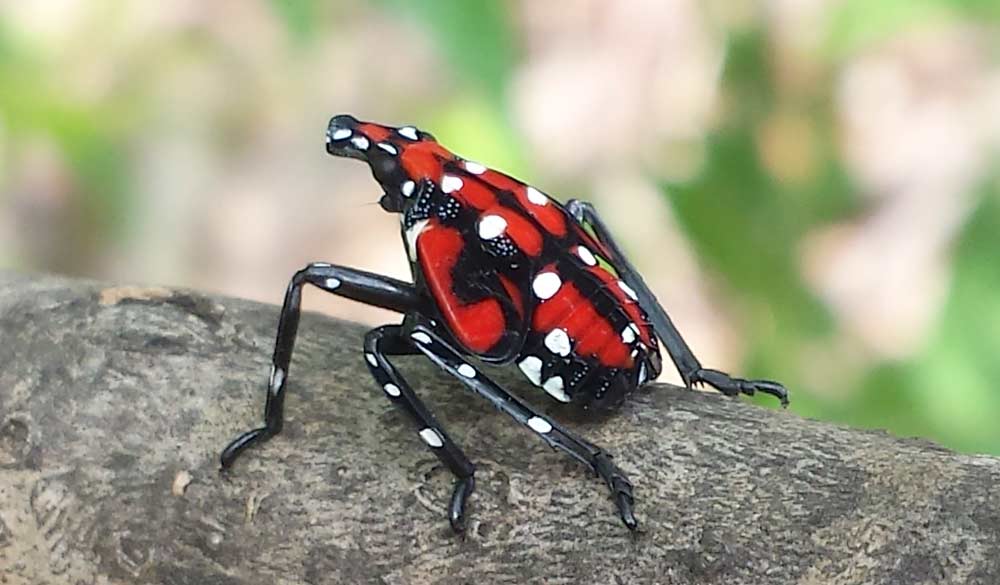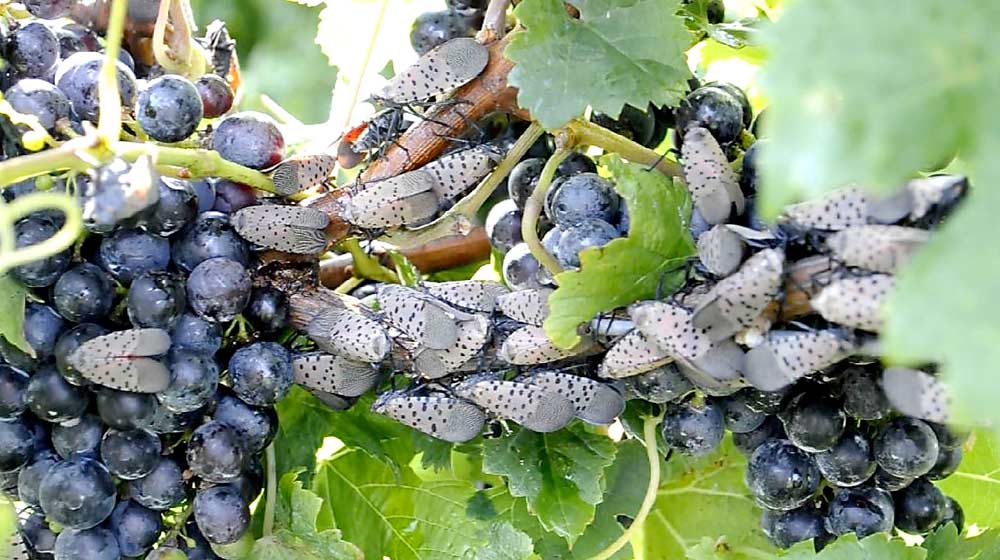
The Spotted Lanternfly is a new invasive pest of concern for grapes, tree fruit, and other woody trees that is found, so far, primarily in Eastern Pennsylvania. Officials have responded quickly to try and contain the pest and encourage the public to be on the lookout, which is easier since it’s such a distinctive insect. (Courtesy Pennsylvania Department of Agriculture)
This beautiful bug is bad news.
The spotted lanternfly, an Asian sap sucker that feeds on woody trees and vines, was first discovered in Eastern Pennsylvania in 2014 and now occurs in 13 counties.
Last summer, the first damage to commercial crops was discovered in vineyards, but concern that the voracious, generalist pest could become another epidemic like the brown marmorated stink bug has officials and growers just west of the quarantine area in the heart of the state’s fruit production region on high alert.
“This past year, because the population basically exploded beyond our expectation, there has been damage in our vineyards in the areas that have excessive populations,” said Fred Strathmeyer, the deputy secretary of plant industry and consumer protection for the Pennsylvania Department of Agriculture. “It has also entered into adjacent apple orchards and been seen a little bit in peaches, but after harvest.”
There’s good news though: Because the spotted lanternfly is so visually striking — adults are about 1-inch long with black spots on grey forewings and red spotted hindwings, that, when closed, give the insects’ wings a speckled, rosy gray look — public awareness of the pest and the risk it poses has grown. The wingless nymphs are black with white spots, and older nymphs turn red as they mature.
“We haven’t had this level of public engagement in the past when it comes to invasive pests,” he said. “That’s absolutely a critical part of the story as to the success we’ve had keeping it mostly contained.”

Spotted Lanternflies lay eggs in brown masses on just about anything, including vehicles and train cars, raising the risk that people will unknowingly spread the pest. (Courtesy Pennsylvania Department of Agriculture)
The spotted lanternfly will lay its egg masses anywhere, from park benches to truck bumpers. That means that checking anything moving in and out of the quarantine area — not just nursery stock, yard waste and timber — for the insects and their mud-gray egg masses is paramount.
“It’s a great hitchhiker,” Strathmeyer said. “The rail system really worries me. They could lay eggs on a rail car that could end up, I hate to say it, in Washington state. That just complicates the problem.”
Last fall, the spotted lanternfly was also found for the first time in Delaware, and a dead specimen was found in New York in a shipping facility.
Echoes of the region’s experience with another Asian invader, brown marmorated stink bugs, spurred a more urgent response to the spotted lanternfly. BMSB were first discovered — also in Eastern Pennsylvania — 20 years ago, and by 2010 the pest cost mid-Atlantic apple growers $37 million in losses before better control strategies were developed.
“When BMSB was found, unfortunately no one knew enough about how much damage it could cause and how widespread it could go,” Strathmeyer said, “If there’s a silver lining in this story, it’s that we jumped on this thing pretty quickly and we’ve been able to contain it so far.”
Like BMSB, the lanternfly has a wide range of host plants and can move from native woodlands to farms, but it doesn’t damage fruit directly. Nymphs and adults both suck sap from stems and leaves, weakening plants. They also produce honeydew, which promotes molds that can damage fruit.
Tree of heaven, an invasive tree that’s common across the Eastern U.S., appears to be a preferred host for the spotted lanternfly.

Spotted Lanternfly damage was reported on grapes in Eastern Pennsylvania this year, but so far it’s been contained so that the major tree fruit growing region in the central part of the state is spared, although growers are on high alert of signs of the pernicious new pest. (Courtesy Pennsylvania Department of Agriculture)
At present, no insecticides are labeled to control the pest, but Penn State University scientists are working on the issue and hope to have management recommendations for tree fruit soon. Researchers have also traveled to China to study the pest in its native habitat, Strathmeyer said.
Officials are encouraging growers and homeowners in the Mid-Atlantic and Northeast regions to keep a close eye out for the insect and to report and destroy any egg masses they find. Containment is the goal, but limiting the movement of a hitchhiking pest in a densely populated area with interstate commuting and commerce poses challenges.
“We’re holding our breath a little bit on what happens come spring,” Strathmeyer said. He said the U.S. Department of Agriculture has supported the state’s efforts to limit the lanternfly’s movement, but it’s going to continue to be an expensive effort for the region’s businesses and regulators. He urged grower groups in other parts of the U.S. to support Pennsylvania’s requests for federal funding.
“If we can drum up that kind of support from other national organizations, that would be very helpful in making the case to the USDA and the federal government that we need support here to keep it as contained as possible,” he said. •
—by Kate Prengaman
Editor’s note: This story as it was published in the March 1, 2018 issue incorrectly implied that its native habitat included the Korean peninsula. In fact, it’s been an invasive species of concern in South Korea since its introduction about a decade ago. The sap sucker is native to China, India, and Vietnam. The error has been corrected online.






Leave A Comment